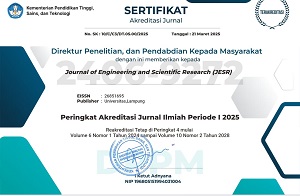Frequency Stability Control In Low -Inertia Power System Using Virtual Synchronous Generator
DOI:
https://doi.org/10.23960/jesr.v3i1.56 - Abstract View: 406Abstract
The stability of the electric power system is divided into transient stability, steady state stability and dynamic stability. Things that affect the performance of the generator include the addition of generators, changes in the load that vary in the system which have an impact on system stability and the distance between the generator and the load. The addition of a Virtual Synchronous Generator (VSG) is needed to improve the power system that is integrated with Renewable Energy Systems Source in maintaining system stability. When the integration between conventional generators and Renewable Energy Systems Source without Virtual Synchronous Generator (VSG) has a frequency response of 58.2 Hz when the generating capacity is -40% of the initial state, while integration between conventional generators and Renewable Energy Systems Source with Virtual Synchronous Generator (VSG) has a steady state response of 60 Hz even though the generating condition is 40% of the initial capacity of the generator. This means that the Virtual Synchronous Generator (VSG) can stabilize the return frequency in its nominal value on the system.
Keywords : Inertia, Conventional Generating, Renewable Energy Systems Source, Virtual Synchronous Generator (VSG).
Downloads







